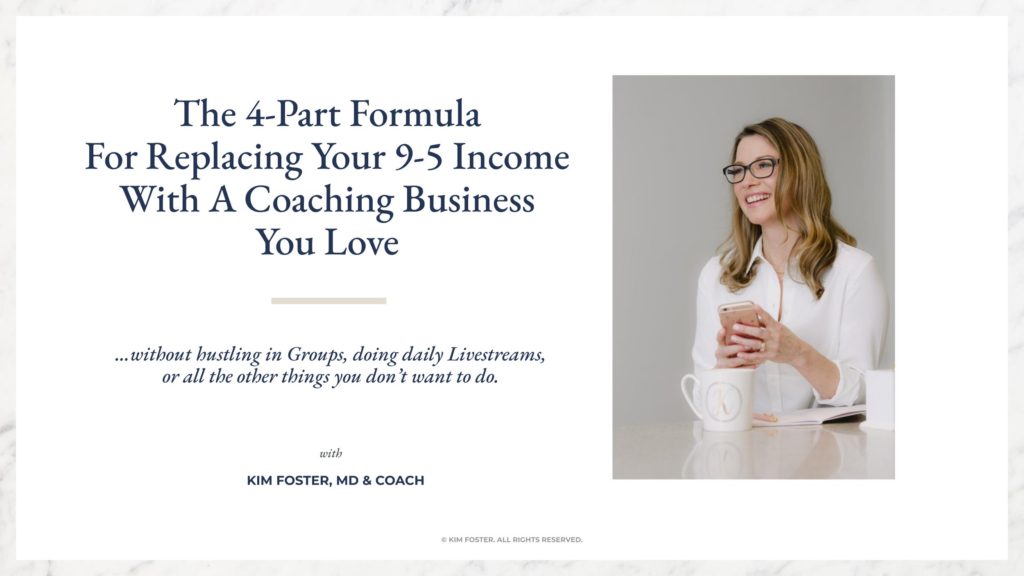
If you’re struggling over how to choose a price for your coaching programs and packages, then you’re not alone! Many coaches—especially new coaches—have a tough time knowing how much to charge for their services.
In this article (and podcast episode) I’m going to give you some concrete tips to help you charge the right price for your coaching programs and services. I look at 5 separate issues that will influence your pricing decision, to help you choose your “sweet spot” pricing.
I also give you some examples of real prices my clients are actually charging (and getting!) for their packages, so you have an idea of what’s really happening in the marketplace.
And I answer the question: should you list your prices on your website (this came up recently inside my group program, Business Academy for Coaches) and I give you my heavily-biased opinion on how to handle this issue!
By the way, if you’d rather listen than read, here’s where you can tune in to this episode:
Now, before we get started…I want to invite you to my brand new free training, it’s a masterclass I created called: The 4-Part Formula For Replacing Your 9-5 Income With A Coaching Business You Love, and that’s exactly what I teach you, inside the class. I’ll tell you a little more about it at the end of this post, but if you’re keen to check out the details now, head over to https://drkimfoster.com/businesstraining to find out what I’ll be talking about, and how you can reserve your seat.

So let’s dive into today’s topic!
Let’s talk about how to pick the perfect price for your programs so you never struggle to sell your services and you never struggle to make enough money in your business.
ISSUE #1: THE OUTCOME OF YOUR PROGRAM
The first thing that you want to consider is the value of your coaching program. So many new coaches make the mistake of thinking that they should be charging by the hour. They set their prices based on the amount of time a client gets with them, or maybe for the number of workbooks and videos and other STUFF you’re giving your client, but that is a big mistake.
You don’t want your clients to assess your value based on how many hours or how much stuff you give them. Instead you want them to Value you based on the results and the outcome you get for them.
Now, those results can be tangible or intangible, or both, but the best kinds of outcomes are very specific, highly desirable outcomes.
Some examples of tangible outcomes are: reduced medical expenses, reduced legal expenses, increased sales, a better career or a more higher-paying job.
Examples of intangible outcomes are things like more joy or happiness a longer life a better life a higher quality of life. But be cautious with these kinds of outcomes — you really don’t want to leave them in this vague territory of “more happiness” and instead translate it into something much more specific.
I recommend that you make a long list of the exact outcomes and all the tangible and intangible benefits that your clients will experience by working with you, and that is what you’re charging for.
ISSUE #2: TIME CONSIDERATIONS
The second thing you want to look at is the value of your time and how much time you’re actually investing in your program. Now , although the results and the outcomes are the most important thing to focus on, your time does play a role in how much you’ll charge, because time is limited. We only have so much time in our day.
So I want you to look at how many hours of your precious time you’re actually investing in your coaching, including your one-to-one sessions, Q&A calls, responding to email, responding to social media messages, personalized reviews and all the things you are putting in your coaching that take up your time.
And of course a 6 week program will be at a lower price point than a 6 months program, so all of those things need to be factored in.
ISSUE #3: WHAT WILL THE MARKET BEAR?
The third thing to consider is: what will the market bear? Essentially, what are the going rates? What are your competitors charging? What is even possible, in the coaching marketplace?
In the beginning of this episode I promised to give you some actual benchmarks, so here we go. Let’s talk about what our coaching clients are actually charging for their coaching programs shall we?
My clients who are brand new coaches, right at the beginning, what I usually encourage them to do is set their prices as close to a premium range as possible. So, for a 90-day program that is a private program, weekly coaching sessions, I suggest a starting price anywhere from $1000-3000. Some of my clients who are brand new to coaching, have set their prices at $2500, and even $3500 for a 90-day program, or much more for a 6-month program, and they have enrolled clients at those rates.
Now, of course, this is a benchmark. It’s really going to depend on a lot of factors, and it’s something I work closely with my clients and group participants to figure out their own sweet spot pricing.
For my clients who are more experienced coaches, again I strongly encourage them to push their prices into the premium range — and we’ll talk about why in just a minute — but when you are perhaps an intermediate, or more experienced coach, you can command rates anywhere from 4000 for a 90-day program, up to 6,7,8K or more. Truly, the more experienced and in-demand you become, as a coach, the higher you can command.
And again, there are a lot of individual variables, like your niche, your industry, your specific outcomes, and things like that.
ISSUE #4: PREMIUM PRICING
Now the fourth thing to consider is really giving yourself permission to charge your worth, and specifically, to charge premium rates.
Let’s talk a bit more about why it is actually good for you and your clients to charge premium rates. I believe that coaching is a field that is highly influenced by pricing psychology.
Perceived value means that when people see a higher price point, they automatically believe that product or service is better. That it’s more effective or will work better … and this applies to your coaching services.
If you think about this for yourself, you have probably experienced this effect. Let’s say you’re shopping for a new appliance, like a coffee maker. You look at the prices, one model is priced at $30. And you see another coffee machine that’s priced at $300.
You will naturally assume that the coffee maker that is $300 is a higher quality. It’s better made, it will do a better job of giving you a really great cup of coffee, and it will last longer. Right?
Your clients will have the same sort of pricing philosophy in your mind when they are looking at you and your pricing and when they compare you to your competitors.
So you want to go out there with a premium price. You’ll be able to benefit from this phenomenon, but the thing is, your clients will benefit, too. When you actually position yourself as an expert and a high-end provider in the industry, not only will clients take you more seriously, they will also get better results, because they will be more committed if they have more skin in the game.
When you’re charging low prices you may actually end up with clients who are less committed.
And it’s not just a perception thing. It plays out in reality, too, because when you charge lower prices, you will end up having to take on more clients to meet your income goals, which means more people on your schedule, and less time for you, plus less time for each client.
With more clients you have much less time to dedicate to each client, and your quality of service might actually decline.
So all of that is why I definitely recommend that you go higher and with your pricing, because it’s not only going to help you earn more but it will also help you provide higher quality services to your clients.
ISSUE #5: SHOULD YOU LIST YOUR PRICES ON YOUR WEBSITE?
Recently, inside my business accelerator program, Business Academy for Coaches, one of the women in there raised the question: what about posting your prices on your website? Should you post them, or should you keep them hidden, and only discuss your actual prices on a phone call.
So we discussed in detail the two different schools of thought on this.
There are advantages and disadvantages to both, but my preference is to post your prices, make them visible to people who are considering your services.
And here’s a story to illustrate the reason why:
When I was in Rome a couple of years ago, I went into a really gorgeous-looking boutique in the Spanish Steps, where we were staying. I immediately loved the feel of the store, it had a minimal kind of feel, great lighting, modern but cozy, and the clothes I saw in the window were absolutely gorgeous. Inside the store I went to the first rack and looked at the blouses hanging there. So pretty and stylish, really unlike anything I typically saw in the stores at home, and I could tell the quality was really good. I pulled out a beautiful cream-colored blouse that I loved the look of and I did what most people do at this point, I went down to the sleeve to check the price tag. There was no tag. Hmm. I looked at the back collar for a tag perhaps there. Nothing. Okay, so I moved onto a different top–more like a jacket, hanging nearby, and I look for the price on that one. No tag.
Oh, I thought. It was one of these boutiques. Clearly if they don’t even have price tags on their clothes, they are not in my budget. I didn’t even bother trying on the blouse or the jacket or any of the other beautiful clothes in the store because I figured no point getting excited about them because there’s no way I could afford them.
I slipped back out of the store, into the cobblestone streets, feeling a bit sad, looking for a gelateria to make me feel better, and then maybe a store that I could afford.
So this, in my opinion, is what happens to your clients when they come to your website and don’t see any prices listed. They assume your services will be way out of their budget, and they just click away, looking for something that is much more in their budget.
People will often expect the worst. Why would they then go ahead and book a discovery call with you, when it very well may end up being a huge waste of time for them? And if there’s one thing people feel even more scarce about than money, it’s time. Nobody wants to get on a call with someone to find out their rates, learn that they are not in the ballpark of what they can manage, and then feel like a jerk that they’ve wasted their time and yours, and have to make up some lame excuse to get off the call. They’re not going to do that, they’re just going to keep searching for somebody else.
You are letting a lot of opportunities click away if you don’t list your prices, in my opinion. Sure, maybe somebody who is really obsessed with your stuff, like a superfan, might book a call, and might not be deterred, but that won’t be the majority, and think about all those lost opportunities.
Plus, I don’t love the sort of “secret” vibe that you set up when you don’t list your prices. It doesn’t feel transparent or forthcoming, and i don’t really like that.
I also think that sometimes people need a little time to let a price point sink in. Many, many times I have had the experience personally of learning the price for something, and feeling that initial gut-punch that there’s no way I could manage it…and then I think about it, sit with it, go back and review the benefits again, absorb a little more….and gradually I start thinking about how I could make it work, because I really do want it. Sometimes that process happens quickly, like in a matter of days, and sometimes it’s slowly…but rarely is it ever in the span of a 30 minute discovery call.
I think people need a beat to get over their sticker shock, and by listing your prices on your site, it gives them that chance, and then once they’ve let it sink in and they realize how much they still really do want what you have on offer…they’ll book that call.
Which also means: you’re only going to get people on the phone with you who are really great pre-qualified leads. They’re serious, they know what they’re getting into, and the conversation is so much less awkward, in my opinion.
Now, this is all personal preference, and based on my experience and observations. But … you do you.
I have some clients who have great reasons for not listing their prices on their site, and it works great for them. So if this is what you’re doing, and it’s working great for you, then I say don’t change a thing!
There are certain situations that I think do work well with an unlisted-prices approach.
For example, if you’re creating a very high-end, or upscale VIP event or package. Things like an in-person VIP day, or an in-person retreat. If your intention is for it to be very exclusive, and with a lot of limiters in size, for example, that may work very well with an unlisted price approach. When you’re catering to that kind of clientele you’re looking to attract the kind of high-flyers that need to complete an application, perhaps. This is an elite offering, and your clients actually expect a very high price tag–in that situation, not listing your prices would be perfectly appropriate, and may actually work better with the brand and the vibe.
RECAP
Okay so there are 5 things to consider when it comes to pricing your programs:
- The value of your program
- The amount of time it will take you to deliver
- What the market will bear, and I gave you some benchmark prices from my own clients
- A premium pricing strategy, perceived value.
- Making a decision about whether to list your prices.
Now that you’ve made some empowered decisions about your pricing for your coaching packages, you might be wondering: where are the clients? You might be very excited, especially now, about connecting with clients and selling your programs.
And if you are I want to invite you to sign up for my free online masterclass where I share with you my 4-part framework to get all the coaching clients you could ever want. When you click that link, you can sign up for free and be attending that training this week.
I also want to mention that the doors are now open for my comprehensive business accelerator program, Business Academy for Coaches!

If you’re done with trying to figure everything out by yourself when it comes to growing a successful online health coaching business, I invite you to check out my complete business-building program, Business Academy for Coaches.
Resources & Links:
- The 4-Part Formula For Replacing Your 9-5 Income With A Coaching Business You Love (my free training)
- Business Academy for Coaches
- Health Coach Squad (my free Facebook Group)
- The best platform for your coaching practice: Practice Better
- The landing page program I recommend: Leadpages
- The email marketing system I recommend: ConvertKit
- 3 Ways To Get New Clients (my free guide): drkimfoster.com/getnewclients
N.B. some links are affiliate links.
Subscribe to my Podcast:





